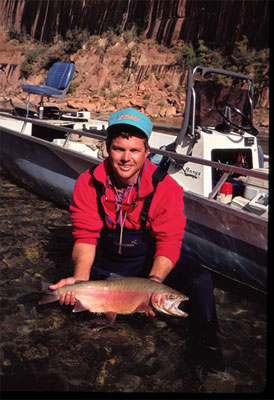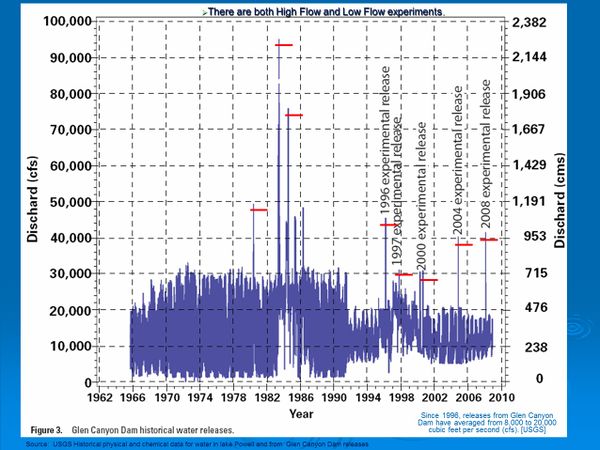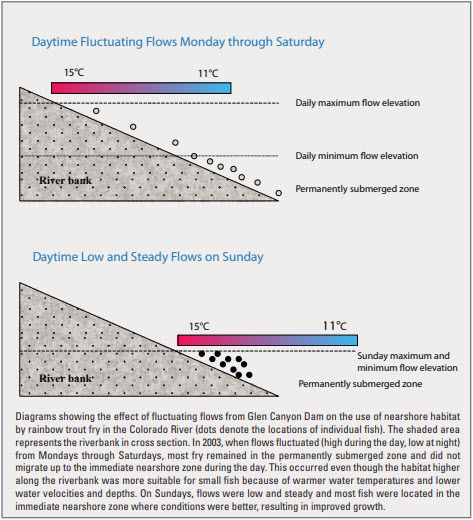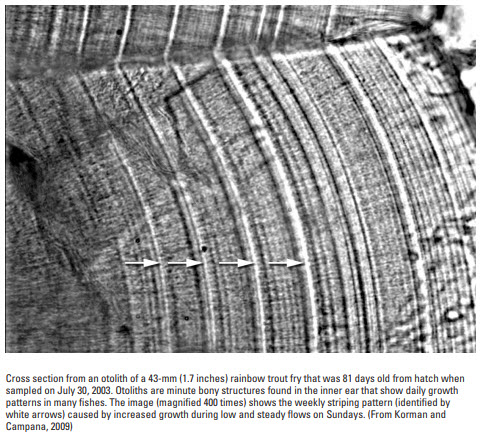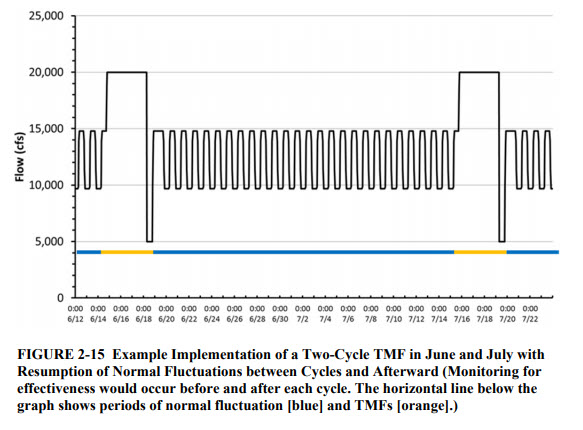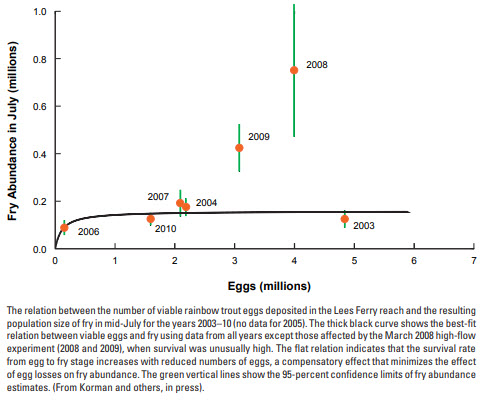Difference between revisions of "Trout Management Flows"
Cellsworth (Talk | contribs) |
Cellsworth (Talk | contribs) |
||
| Line 108: | Line 108: | ||
*Large fluctuations in daily flows is thought to have limited egg survival and age-0 trout recruitment under pre-ROD conditions. | *Large fluctuations in daily flows is thought to have limited egg survival and age-0 trout recruitment under pre-ROD conditions. | ||
| − | ==Scenario 2. Equalization flows that require full power plant releases for an extended period of time== | + | ==Scenario 2: Year of high trout recruitment and immigration into Marble Canyon followed by a sediment input from the Paria== |
| + | |||
| + | |||
| + | |||
| + | ==Scenario 3. Equalization flows that require full power plant releases for an extended period of time== | ||
This scenario describes a combination of possible Trout Management Flows that could be implemented during equalization flows. Conduct a pre-treatment redd count in February and March to get an estimate of trout production. Once every 2-4 weeks beginning in mid-March, reduce releases early in the morning to the lowest allowable minimum release and hold for 10-12 hours to dewater redds. During the day of the treatment when the water levels are low, remove redds located below the minimum flow elevation with a hydraulic pressure washer or a suction dredge (Treatment 1). Repeat every 2-4 weeks until the end of April. Beginning in May, downramp flows one day every 2-4 weeks as fast as allowable to the lowest allowable minimum flow for a nighttime stranding treatment lasting 10-12 hours (Treatment 3). Repeat every 2-4 weeks until the end of the equalization flow (probably September 30). During the first week of October, perform a population estimate on the age-0 trout population to determine the effectiveness of these actions. | This scenario describes a combination of possible Trout Management Flows that could be implemented during equalization flows. Conduct a pre-treatment redd count in February and March to get an estimate of trout production. Once every 2-4 weeks beginning in mid-March, reduce releases early in the morning to the lowest allowable minimum release and hold for 10-12 hours to dewater redds. During the day of the treatment when the water levels are low, remove redds located below the minimum flow elevation with a hydraulic pressure washer or a suction dredge (Treatment 1). Repeat every 2-4 weeks until the end of April. Beginning in May, downramp flows one day every 2-4 weeks as fast as allowable to the lowest allowable minimum flow for a nighttime stranding treatment lasting 10-12 hours (Treatment 3). Repeat every 2-4 weeks until the end of the equalization flow (probably September 30). During the first week of October, perform a population estimate on the age-0 trout population to determine the effectiveness of these actions. | ||
*The 2012 equalization flow increased survival of YOY trout ultimately leading to an over population of trout in the ferry and a subsequent population crash during the winter of 2014-15.[https://www.gcmrc.gov/about/ka/KA%202%20-%2010-19-11/PM%20Talks/Korman_TroutFlowHabUse_PHX_Oct2011.pdf] | *The 2012 equalization flow increased survival of YOY trout ultimately leading to an over population of trout in the ferry and a subsequent population crash during the winter of 2014-15.[https://www.gcmrc.gov/about/ka/KA%202%20-%2010-19-11/PM%20Talks/Korman_TroutFlowHabUse_PHX_Oct2011.pdf] | ||
| − | ==Scenario | + | ==Scenario 4. Spring HFE == |
This scenario describes a combination of possible Trout Management Flows that could be implemented during a spring HFE. Conduct a pre-treatment redd count in February and March to get an estimate of trout production. Once every 2-4 weeks beginning in mid-March, reduce releases early in the morning to the lowest allowable minimum release and hold for 10-12 hours to dewater redds. During the day of the treatment when the water levels are low, remove redds located below the minimum flow elevation with a hydraulic pressure washer or a suction dredge (Treatment 1). Repeat every 2-4 weeks until the end of April. Implement the spring HFE at the end of April. At the conclusion of the spring HFE, downramp flows as fast as allowable to the lowest allowable minimum flow for a nighttime stranding treatment lasting 10-12 hours (Treatment 3). Then proceed with age-0 trout displacement flow treatments by increasing daily flow fluctuations to as high of level as allowable (Treatment 2). Continue with these high flow fluctuations until the end of August. During the first week of September, perform a population estimate on the age-0 trout population to determine the effectiveness of this actions. | This scenario describes a combination of possible Trout Management Flows that could be implemented during a spring HFE. Conduct a pre-treatment redd count in February and March to get an estimate of trout production. Once every 2-4 weeks beginning in mid-March, reduce releases early in the morning to the lowest allowable minimum release and hold for 10-12 hours to dewater redds. During the day of the treatment when the water levels are low, remove redds located below the minimum flow elevation with a hydraulic pressure washer or a suction dredge (Treatment 1). Repeat every 2-4 weeks until the end of April. Implement the spring HFE at the end of April. At the conclusion of the spring HFE, downramp flows as fast as allowable to the lowest allowable minimum flow for a nighttime stranding treatment lasting 10-12 hours (Treatment 3). Then proceed with age-0 trout displacement flow treatments by increasing daily flow fluctuations to as high of level as allowable (Treatment 2). Continue with these high flow fluctuations until the end of August. During the first week of September, perform a population estimate on the age-0 trout population to determine the effectiveness of this actions. | ||
| Line 119: | Line 123: | ||
*Survival rates of YOY trout increased 4x following the March 2008 HFE [https://pubs.usgs.gov/fs/2011/3002/fs2011-3002.pdf] | *Survival rates of YOY trout increased 4x following the March 2008 HFE [https://pubs.usgs.gov/fs/2011/3002/fs2011-3002.pdf] | ||
[[File:TroutFryToEggs.jpg|thumb|center|600px|https://pubs.usgs.gov/fs/2011/3002/fs2011-3002.pdf]] | [[File:TroutFryToEggs.jpg|thumb|center|600px|https://pubs.usgs.gov/fs/2011/3002/fs2011-3002.pdf]] | ||
| + | |||
| + | |||
| + | |} | ||
| + | |||
| + | |||
| + | <!-- | ||
| + | |||
| + | --------------------------------ADDITIONAL-------------------------------> | ||
| + | |class="MainPageBG" style="width:45%; border:1px solid #cedff2; background:#f5faff; vertical-align:top;"| | ||
| + | {| width="100%" cellpadding="2" cellspacing="5" style="vertical-align:top; background:#f5faff;" | ||
| + | ! <h2 style="margin:0; background:#cedff2; font-size:120%; font-weight:bold; border:1px solid #a3b0bf; text-align:left; color:#000; padding:0.2em 0.4em;">Links</h2> | ||
| + | |- | ||
| + | |style="color:#000;"| | ||
| + | |||
| + | *[http://gcdamp.com/index.php?title=FISHERY Rainbow Trout Page] | ||
| + | *[http://gcdamp.com/index.php?title=Brown_Trout Brown Trout Page] | ||
| + | *[http://gcdamp.com/index.php?title=Long-term_Experimental_and_Management_Plan_(LTEMP) LTEMP EIS ] | ||
| + | |||
| + | |- | ||
| + | ! <h2 style="margin:0; background:#cedff2; font-size:120%; font-weight:bold; border:1px solid #a3b0bf; text-align:left; color:#000; padding:0.2em 0.4em;"> '''Data Needs ([http://ltempeis.anl.gov/documents/final-eis/vol1/Chapter_2-Alternatives.pdf LTEMP FEIS Chapter 2, pages 63-66])''' </h2> | ||
| + | |- | ||
| + | |style="color:#000;"| | ||
| + | |||
| + | ===Treatment 1: Redd stranding flows=== | ||
| + | |||
| + | ===Treatment 2: Age-0 Trout Displacement Flows=== | ||
| + | *Optimal fluctuation range | ||
| + | *Optimal ramp rates | ||
| + | *Timing and duration | ||
| + | |||
| + | ===Treatment 3: Age-0 Trout Stranding Flows=== | ||
| + | *Duration of high flows needed to lure YOY rainbow trout into near-shore habitats | ||
| + | *Magnitude of the high flow that would be more effective in luring YOY trout to near-shore habitats | ||
| + | *Whether or not moving to high flows first is needed to reduce YOY trout numbers (as opposed to simply dropping rapidly from normal flows to minimum flows) | ||
| + | *Timing of TMF cycles during the May–August period of trout emergence | ||
| + | *Number of cycles necessary to effectively limit trout recruitment | ||
| + | *Can an action like this overcome density-dependent mortality? [https://www.gcmrc.gov/about/ka/KA%202%20-%2010-19-11/PM%20Talks/Korman_TroutFlowHabUse_PHX_Oct2011.pdf ] | ||
| + | |||
| + | ===Treatment 4: Increase or Maintain Turbidity=== | ||
| + | |||
| + | |- | ||
| + | ! <h2 style="margin:0; background:#cedff2; font-size:120%; font-weight:bold; border:1px solid #a3b0bf; text-align:left; color:#000; padding:0.2em 0.4em;"> Other Resources that may be affected </h2> | ||
| + | |- | ||
| + | |style="color:#000;"| | ||
| + | |||
| + | *Hydropower: value, capacity | ||
| + | *Foodbase: production, drift, availability | ||
| + | *Native fish: stranding | ||
| + | *Tribal sensitivities: sanctity of life | ||
| + | *Lees Ferry fishery: access, economics | ||
| + | *Boater safety: Glen Canyon, downstream | ||
| + | *Sediment transport: beaches | ||
| + | |||
| + | |- | ||
| + | ! <h2 style="margin:0; background:#cedff2; font-size:120%; font-weight:bold; border:1px solid #a3b0bf; text-align:left; color:#000; padding:0.2em 0.4em;">Presentations and Papers</h2> | ||
| + | |- | ||
| + | |style="color:#000;"| | ||
| + | |||
| + | '''2017''' | ||
| + | *[https://pubs.er.usgs.gov/publication/70187999 Korman et al. 2017. Trends in rainbow trout recruitment, abundance, survival, and growth during a boom-and-bust cycle in a tailwater fishery. TAFS] | ||
| + | *[https://www.usbr.gov/uc/rm/amp/twg/mtgs/17jan26/AR11_Bair.pdf Is rainbow trout control necessary, and if so, what is the most cost-effective approach? ppt] | ||
| + | |||
| + | '''2016''' | ||
| + | *[https://www.usbr.gov/uc/rm/amp/twg/mtgs/17jan26/AR15_Korman.pdf Boom-and-Bust Cycles in the Population of Rainbow Trout in Glen Canyon and Effects of Fall High Flow Experiments ppt] | ||
| + | |||
| + | '''2015''' | ||
| + | *[http://onlinelibrary.wiley.com/doi/10.1080/02755947.2015.1040560/abstract Avery et al. 2015. Effects of Increased Discharge on Spawning and Age-0 Recruitment of Rainbow Trout in the Colorado River at Lees Ferry, Arizona. NAJFM] | ||
| + | |||
| + | '''2013''' | ||
| + | *[https://www.gcmrc.gov/about/annaul_reporting/2014%20Poster%20Session/Avery_2013%20Effects%20of%20recent%20flow%20events%20on%20juv.%20RBT.pdf Effects of Recent Flow Events on the Juvenile Rainbow Trout Population in Lees Ferry (poster)] | ||
| + | |||
| + | '''2012''' | ||
| + | *[https://www.azgfd.com/PortalImages/files/wildlife/research/Reports/Korman_etal2012_CanJFAS%20Estimating%20Recruitment%20Dynamcis%20and%20Movements%20of%20Rainbow%20Trout%20%28Oncorhynchus%20mykiss%29%20in%20the%20Colorado%20River%20in%20Grand%20Canyon%20Using%20an%20Integrated%20Assessment%20Model.pdf Korman et al. 2012. Estimating recruitment dynamics and movement of rainbow trout (Oncorhynchus mykiss) in the Colorado River in Grand Canyon using an integrated assessment model. Can. J. Fish. Aquat. Sci] | ||
| + | *[https://www.usbr.gov/uc/rm/amp/twg/mtgs/12feb02/Attach_08.pdf A Research and Monitoring Plan for Evaluating Trout Management Flows below Glen Canyon Dam ppt] | ||
| + | *[https://www.usbr.gov/uc/rm/amp/amwg/mtgs/12feb22/Attach_07e.pdf Proposed Monitoring and Research Plan for Evaluating Trout Management Flows below Glen Canyon Dam PPT] | ||
| + | *[https://www.usbr.gov/uc/rm/amp/twg/mtgs/12feb02/Attach_08.pdf A Research and Monitoring Plan for Evaluating Trout Management Flows Below Glen Canyon Dam and PPT] | ||
| + | *[https://www.gcmrc.gov/about/ka/KA%202%20-%2010-19-11/PM%20Talks/Korman_TroutFlowHabUse_PHX_Oct2011.pdf Trout Management Flows and Age-0 Habitat Use ppt] | ||
| + | |||
| + | '''2011''' | ||
| + | *[https://pubs.usgs.gov/circ/1366/c1366.pdf Melis, T. S., ed., 2011, Effects of three high-flow experiments on the Colorado River ecosystem downstream from Glen Canyon Dam, Arizona: U.S. Geological Survey Circular 1366] | ||
| + | *[https://pubs.usgs.gov/fs/2011/3002/fs2011-3002.pdf The Effects of Glen Canyon Dam Operations on Early Life Stages of Rainbow Trout in the Colorado River. USGS Fact Sheet ] | ||
| + | *[http://www.fishsciences.net/reports/2011/CJFAS_68_1097-1109.pdf Korman et al. 2011. Effects of flow fluctuations on habitat use and survival of age-0 rainbow trout (Oncorhynchus mykiss) in a large, regulated river. CJFAS.] | ||
| + | *[http://onlinelibrary.wiley.com/doi/10.1080/00028487.2011.572015/abstract Korman et al. 2011. Effects of Fluctuating Flows and a Controlled Flood on Incubation Success and Early Survival Rates and Growth of Age-0 Rainbow Trout in a Large Regulated River. TAFS] | ||
| + | |||
| + | '''2010''' | ||
| + | *[http://www.gcmrc.gov/about/ka/KA%202%20-%2010-19-11/PM%20Talks/Korman_TroutFlowHabUse_PHX_Oct2011.pdf Hourly and Seasonal Variation in Nearshore Habitat Use by Age-0 Rainbow Trout In Lees Ferry: Implications for Nonnative Fish Suppression Flow Experiments ppt] | ||
| + | |||
| + | '''2009''' | ||
| + | *[https://www.researchgate.net/publication/241652808_Effects_of_Hydropeaking_on_Nearshore_Habitat_Use_and_Growth_of_Age0_Rainbow_Trout_in_a_Large_Regulated_River Korman and Campana. 2009. Effects of Hydropeaking on Nearshore Habitat Use and Growth of Age 0 Rainbow Trout in a Large Regulated River. TAFS] | ||
| + | *[http://www.tandfonline.com/doi/abs/10.1577/T08-025.1?src=recsys&journalCode=utaf20 Korman et al. 2009. Effects of Fish Size, Habitat, Flow, and Density on Capture Probabilities of Age-0 Rainbow Trout Estimated from Electrofishing at Discrete Sites in a Large River. TAFS] | ||
| + | |||
| + | |- | ||
| + | ! <h2 style="margin:0; background:#cedff2; font-size:120%; font-weight:bold; border:1px solid #a3b0bf; text-align:left; color:#000; padding:0.2em 0.4em;">Operational constraints for TMFs</h2> | ||
| + | |- | ||
| + | |style="color:#000;"| | ||
| + | |||
| + | '''Minimum release:''' | ||
| + | *8,000 cfs between 7 a.m. and 7 p.m.?? | ||
| + | *5,000 cfs between 7 p.m. and 7 a.m.?? | ||
| + | *Lower releases limited by boating safety concerns | ||
| + | |||
| + | '''Maximum release:''' | ||
| + | *20,000 cfs (LTEMP example) | ||
| + | *32,000 cfs (powerplant) | ||
| + | *47,000 cfs (powerplant + bypass) | ||
| + | *Limited by powerplant maintenance and monthly volume | ||
| + | |||
| + | '''Daily range:''' | ||
| + | *No limit | ||
| + | |||
| + | '''Ramp rates:''' | ||
| + | *4,000 cfs/hr up (LTEMP example) | ||
| + | *15,000 cfs/hr down (LTEMP example) | ||
| + | *No limit up or down?? | ||
| + | |||
| + | |- | ||
| + | ! <h2 style="margin:0; background:#cedff2; font-size:120%; font-weight:bold; border:1px solid #a3b0bf; text-align:left; color:#000; padding:0.2em 0.4em;"> [https://drive.google.com/file/d/0BwY-Z2c3NTUGUmxPbko2dm9URms/view Lees Ferry Anglers Trout Fishery Recommendations ]</h2> | ||
| + | |- | ||
| + | |style="color:#000;"| | ||
| + | |||
| + | '''Recommendation #5.''' | ||
| + | |||
| + | Under certain conditions, rainbow trout at Lees Ferry have reproduced prolifically. Historically, when there is an over-abundance of young-of-year rainbow trout, the quality and condition of rainbow trout decline. This is likely due to the low quality and low abundance of food sources in Lees Ferry. Trout Management Flows (TMFs) are flow treatments that are hypothesized to reduce the abundance of young-of-year trout by stranding trout shortly after they emerge from their redds (Korman, Ecometric Research, Inc., personal communications, 2015). | ||
| + | |||
| + | We believe the best long term and ecologically appropriate solution to controlling trout densities is to increase invertebrate diversity and manage Grand Canyon Dam flows to avoid excessive trout spawning and recruitment (see recommendations related to the aquatic food base and equalization flows). We are concerned about the collateral damage that TMFs could have on other resources especially the aquatic food base and native fish. TMFs may be especially useful when spring HFE's are implemented or in years when high equalization flows are required. | ||
| + | |||
| + | TMF's should only be implemented in a carefully designed experimental framework that includes quantified criteria for success (for managing trout recruitment and improving the humpback chub population) and the impacts to other resources, especially the aquatic food base, are fully assessed. TMF's should only be used when the rainbow trout population is stable and includes a healthy abundance of all size classes of rainbow trout. Mitigation measures such as emergency stocking of trout need to be in place prior to the implementation of TMFs in case of catastrophic loss to the fishery (see recommendations on Trout Stocking). In conclusion, the experimental evaluation of TMFs needs to recognize the trout fishery as a highly valued asset. The AZGFD should have a seat at the table along with Federal agencies on any discussion and decisions related to implementation of TMFs. | ||
|- | |- | ||
| Line 269: | Line 400: | ||
Little Colorado River reach. TMFs would be tested early in the experimental | Little Colorado River reach. TMFs would be tested early in the experimental | ||
period, preferably in the first 5 years. Under the LTEMP EIS, TMFs could occur from May to August. | period, preferably in the first 5 years. Under the LTEMP EIS, TMFs could occur from May to August. | ||
| − | |||
| − | |||
| − | |||
| − | |||
| − | |||
| − | |||
| − | |||
| − | |||
| − | |||
| − | |||
| − | |||
| − | |||
| − | |||
| − | |||
| − | |||
| − | |||
| − | |||
| − | |||
| − | |||
| − | |||
| − | |||
| − | |||
| − | |||
| − | |||
| − | |||
| − | |||
| − | |||
| − | |||
| − | |||
| − | |||
| − | |||
| − | |||
| − | |||
| − | |||
| − | |||
| − | |||
| − | |||
| − | |||
| − | |||
| − | |||
| − | |||
| − | |||
| − | |||
| − | |||
| − | |||
| − | |||
| − | |||
| − | |||
| − | |||
| − | |||
| − | |||
| − | |||
| − | |||
| − | |||
| − | |||
| − | |||
| − | |||
| − | |||
| − | |||
| − | |||
| − | |||
| − | |||
| − | |||
| − | |||
| − | |||
| − | |||
| − | |||
| − | |||
| − | |||
| − | |||
| − | |||
| − | |||
| − | |||
| − | |||
| − | |||
| − | |||
| − | |||
| − | |||
| − | |||
| − | |||
| − | |||
| − | |||
| − | |||
| − | |||
| − | |||
| − | |||
| − | |||
| − | |||
| − | |||
| − | |||
| − | |||
| − | |||
| − | |||
| − | |||
| − | |||
| − | |||
| − | |||
| − | |||
| − | |||
| − | |||
| − | |||
| − | |||
| − | |||
| − | |||
| − | |||
| − | |||
| − | |||
| − | |||
| − | |||
| − | |||
| − | |||
| − | |||
| − | |||
| − | |||
| − | |||
| − | |||
| − | |||
| − | |||
| − | |||
| − | |||
| − | |||
| − | |||
| − | |||
| − | |||
| − | |||
| − | |||
|- | |- | ||
Revision as of 11:19, 13 July 2018
|
|
Trout Management FlowsThe purpose of implementing Trout Management Flows (TMFs) is to evaluate methods for using releases from Glen Canyon Dam to reduce the production of large numbers of age-0 rainbow trout in order to improve the quality of the Lees Ferry trout fishery and conserve the endangered humpback chub and other native fishes in Grand Canyon. Three objectives were identified for Trout Management Flows:
TMFs under the LTEMP EIS were timed to target rainbow trout and can be scheduled to occur from May to August. The windows for effectiveness for brown trout is thought to be February to April. The drivers for TMFs are relatively untested and and their affects are largely unknown. |
| Rainbow Trout | Brown Trout |
|---|
|
|
